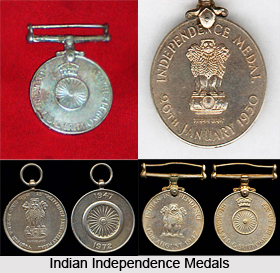The Indian Independence Medal 1947 was awarded to the members of the Indian armed forces who served on 15th August 1947, including the rulers and the state forces of the Princely States of India, which had acceded to the Union of India before 1 January 1948. It was instituted by George VI in the year 1949 as a commemorative medal. The medal was also utilised to reward the British military service personnel who remained in the country after independence in order to support the re-structuring and re-establishment of the Indian armed forces. They were compensated for their contribution after the Partition of India and the formation of the Dominion India in August 1947, who were still serving on 1 January 1948.
 Details of Indian Independence Medal
Details of Indian Independence Medal
The Indian Independence Medal was established by King George VI in October 1949. the obverse of the medal is circular 36 mm copper nickel medal that has the Ashoka chakra inscribed along with a Crown and the surrounding legend :GEORGIUS: VI D: G: BRITT: OMN: RED: FID: DEF." This was the first usage of the new royal titles without bearing any reference to Emperor of India. The medal is suspended by a straight non-swiveling bar and is generally named on the edge. The reverse of the Indian Independence Medal includes the national emblem, but does not contain the motto. The legend "INDIAN INDEPENDENCE/ 15TH AUGUST 1947" is inscribed on this side. The medal also includes a 30 mm ribbon that consists of 3 equal stripes of orange, white and green, each of 10 mm width.
Independence Medal of 1950
The Indian Independence Medal 1950 was awarded to police service personnel in order commemorate the country`s attainment of Republic Status on 26th January, 1950. This medal has nothing to do with the Independence of India in 1947. The Indian Independence Medal 1950 was given as a reward to every member of the Indian Police force who served on 26th January 1950, when the nation was confirmed as a Republic country. This 36 mm copper nickel medal has a 32 mm ribbon with a 9mm light saffron central stripe, a 2mm dark blue stripe that divides the red and saffron on either side. The medal is suspended by a straight non-swiveling bar. The Indian Independence Medal 1950 was a misnamed medal that was awarded in recognition of the service provided by the Indian police force during the Partition of India.



















